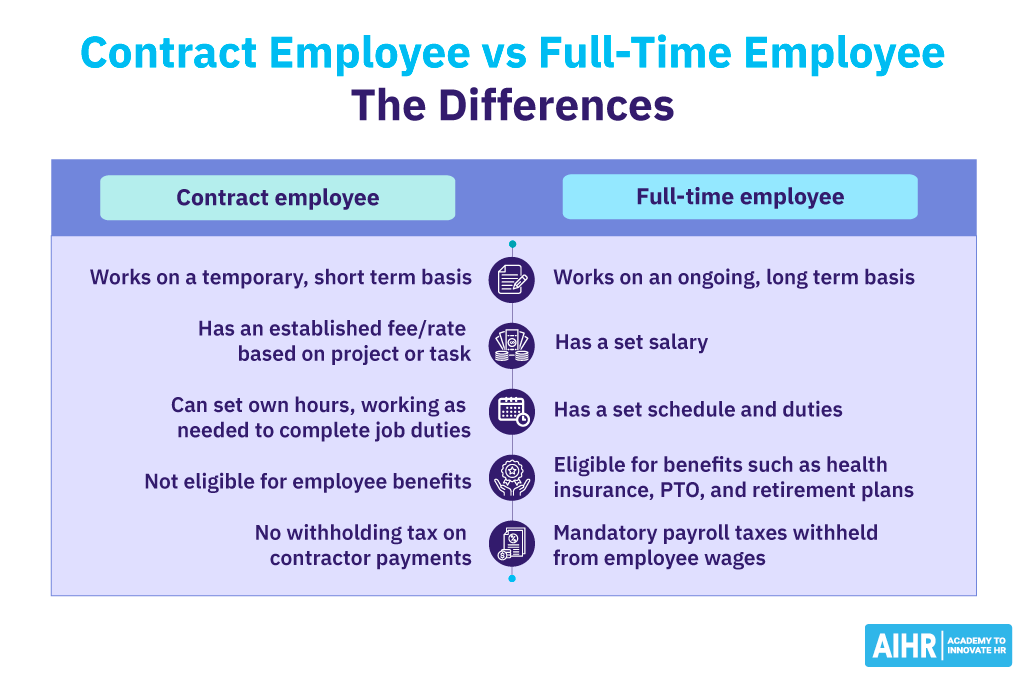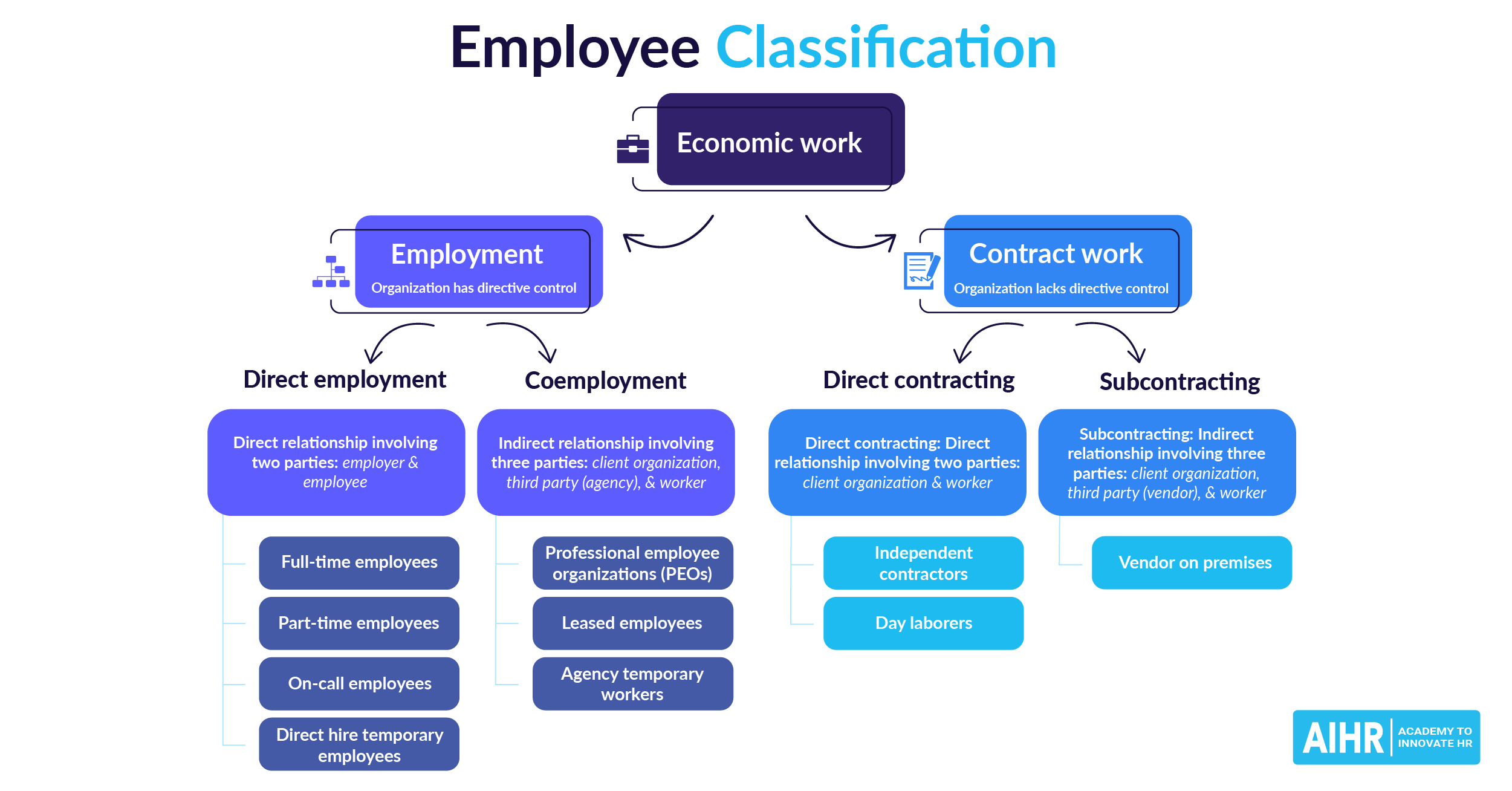Contract Employee
What is a contract employee?
A contract employee is someone who is hired for a fixed period of time to work on a specific project or set of tasks. A formal contract typically outlines the scope of work, project duration, pay, and other employment terms.
Unlike regular employees, contract employees are typically not considered permanent members of staff and often do not receive the same benefits (like health insurance, paid time off, or retirement plans). Generally, this employee is chosen because they have a specific set of skills or expertise that meets a company’s needs. For example, a company may hire a social media specialist for a three-month marketing campaign.
Contract employee vs. full-time employee
| Contract employee | Full-time employee | |
| Relationship | Temporary Short-term | Ongoing Long-term |
| Pay | Established fee/rate based on project/task | Set salary |
| Work schedule | Can set own hours, working as needed to complete job duties | Has a set schedule and duties |
| Benefits | Not eligible for benefits | Eligible for benefits such as health insurance, paid time off, and retirement plans |
| Taxes | No withholding tax on contractor payments | Mandatory payroll taxes withheld from employee wages |
Contract employee vs. independent contractor
Although sometimes used interchangeably, there are some key differences between a contract employee and an independent contractor.
Contract employees typically work for a company under a formal employment contract. Although they are not permanent employees, they are still considered as employed by the company. However, an independent contractor is self-employed, providing services as a separate business entity. They are not employed by the company and have more control over how, when, and where they work.

Contract employee examples
Some of the most common positions for this kind of employee include:
- Software developers: Contract software developers may work on a project basis to develop new systems, websites, apps, and custom software solutions.
- Information technology (IT) consultants: IT consultants often work on a contract basis to provide specialized expertise such as cybersecurity, network infrastructure, or software implementation.
- Marketing and communications: Contract professionals in marketing and communications may be hired for specific projects such as website content creation, social media management, public relations, or product launch materials.
- Finance and accounting: During specific times of the year, companies may hire contract employees to support with financial audits, tax preparation, or financial analysis.
- Graphic designers: Marketing teams frequently use graphic designers on a contract basis for projects such as website design, illustrations, logo designs, etc.
Advantages and disadvantages of hiring contracted employees
Hiring contract workers comes with benefits and some challenges. Here are some key ones HR teams should consider:
Advantages
- Access to specialized skills: When certain skills are difficult to find internally, using contract workers is a quick solution to get in-demand skills your organization needs.
- Short-term commitment: Since contract employees have a specific end date, companies do not have to commit to an open-ended employee relationship.
- Cost savings: Hiring contract employees may cost less than permanent employees, saving costs on health insurance, professional development, or other employee resources.
- Increased flexibility: Contract workers allow companies to fill staffing needs quickly, especially for temporary projects, busy periods, or unexpected employee leave.
Disadvantages
- Lack of long-term commitment: Contracted employees may not be as committed to the company’s long-term goals and culture, as their focus is often on the specific terms of their contract.
- Limited integration into company culture: Due to the short-term work period of contracted employees, they may not be fully connected to the company culture. This lack of integration can also affect team dynamics and collaboration efforts.
- Training and integration challenges: While contractors bring specialized skills, they may still require time to understand specific company processes, which can be a challenge if they are only on board for a short period.
- Overdependence on external talent: Relying on contract workers may limit the skill development and career advancement of permanent employees.
How can HR hire a contract employee
Here is a step-by-step guide HR professionals can use to help navigate the process of hiring a contract employee:
- Identify the hiring need: Determine the specific skills and expertise needed for a desired project or set of tasks. Evaluate if a contract employee is truly needed.
- Define the job scope and timeframe: Clearly define the responsibilities, deliverables, and contract time period.
- Develop a targeted recruitment approach: Determine the best recruitment strategy to source a contracted employee, identifying specific job boards, platforms, staffing agencies, and social media networks.
- Negotiate contract terms: After successfully recruiting a contracted employee, clearly define the terms of the contract, such as project deliverables, pay, and hours.
- Comply with IRS rules: Ensure you comply with IRS rules for 1099 independent contractors versus W-2 employees to avoid misclassification issues.
- Onboarding: Provide a specific onboarding process needed for the contract employee to transition smoothly into the project, team, and company.
HR tip
Although the tenure of a contract employee may be short, it’s important to integrate them into the company culture. This effort will not only create a sense of belonging, it can also boost productivity and performance. Beyond onboarding and orientation, some ways to effectively integrate these employees involve including them in relevant communication channels, company events, and social activities.







